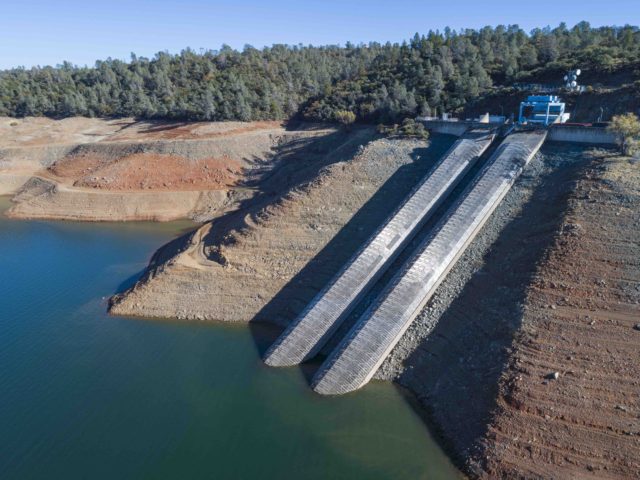California is planning to take a major hydroelectric power plant offline later this summer during a season of peak demand because extreme drought means there is not enough water available to run its turbines.
The Los Angeles Times reported Wednesday:
According to state water officials, the Edward Hyatt Powerplant at Lake Oroville could go offline as soon as August or September — a time frame that would coincide with a feared power crunch this summer. The plant, which opened in the late 1960s, has never been forced offline by low lake levels before.
…
California Energy Commission spokesperson Lindsay Buckley said the commission is actively planning for the power plant to go offline this summer. But the Hyatt power plant is far from the only hydroelectric power source in the state that will likely be affected by California’s extreme weather.
…
Like many things in California, recent travails at Lake Oroville have been a tale of extremes. In 2017, millions of gallons of water eroded the dam’s main and emergency spillways, forcing the evacuation of thousands of residents. The 2016-17 rain season was one of the wettest in California history, bringing more water to Lake Oroville than the reservoir could hold, which was one of several factors that led to the 2017 crisis.
Just four and a half years later, fortunes on the banks of the lake look vastly different. Aerial pictures of the reservoir — a key stockpile of California water supply and a popular recreation destination — have come to symbolize the current drought, with houseboats dwarfed by the steep banks and boat ramps that stop well above the water line. Lake Oroville is currently at 661 feet elevation with 982,000-acre feet of storage, which is 28% of its total capacity and 36% of its historical average, according to the California Department of Water Resources.
The loss of hydroelectric power would pose a challenge to the state’s electrical grid, which suffered rolling blackouts late last summer in the midst of a heat wave, as solar and wind power failed to meet the state’s surging energy needs.
Already, state authorities have issued several “flex alerts” this year, asking residents to conserve electricity during peak demand hours in the afternoon and evening. The state has tried to wean itself from fossil fuels and nuclear power, but renewables are not yet reliable enough.
Hydroelectric power accounts for over 10% of California’s energy consumption.
Joel B. Pollak is Senior Editor-at-Large at Breitbart News and the host of Breitbart News Sunday on Sirius XM Patriot on Sunday evenings from 7 p.m. to 10 p.m. ET (4 p.m. to 7 p.m. PT). He is the author of the recent e-book, Neither Free nor Fair: The 2020 U.S. Presidential Election. His recent book, RED NOVEMBER, tells the story of the 2020 Democratic presidential primary from a conservative perspective. He is a winner of the 2018 Robert Novak Journalism Alumni Fellowship. Follow him on Twitter at @joelpollak.

COMMENTS
Please let us know if you're having issues with commenting.